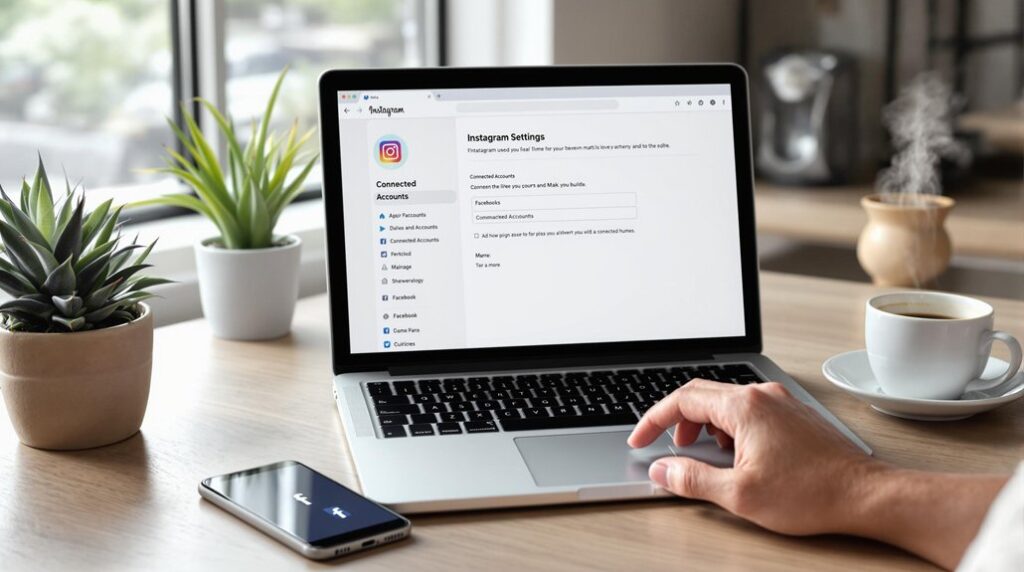Creating a Facebook content calendar is essential for year-round audience engagement and involves several strategic steps. Start by defining SMART objectives to guide your content planning. Identify key themes that align with your brand and audience interests, incorporating seasonal and industry trends. Choose an ideal posting frequency by analyzing engagement patterns and adjust accordingly. Select varied content types like visuals, interactive posts, and user-generated material. Utilize tools and templates for streamlined scheduling. Monitor performance metrics regularly to adapt and refine your strategy. Implement these steps to guarantee your content remains relevant, engaging, and aligned with your business goals, generating sustained interest and interaction.
Key Takeaways
- Define clear objectives using the SMART framework to align content with business goals.
- Identify key themes, including seasonal and industry trends, to maintain varied and relevant content.
- Determine optimal posting frequency; aim for 1-2 posts per day to balance engagement without overwhelming.
- Monitor audience response through Facebook Insights to refine content strategy and posting schedules.
- Leverage diverse content types like videos, images, and interactive elements to keep the audience engaged.
Define Your Objectives
To effectively create a Facebook content calendar, it is vital to first clearly define your objectives. Start by employing the SMART framework to set goals that are Specific, Measurable, Achievable, Relevant, and Time-bound. This structured approach guarantees that objectives like increasing brand awareness by 25% or generating 15% more leads within six months are concrete and trackable.
Additionally, incorporating key metrics and KPIs such as engagement rates and click-through rates can help in measuring your success more accurately.
Objective alignment with broader business goals, such as driving website traffic or enhancing customer engagement, is essential. This alignment guarantees that your Facebook content strategy remains focused and pertinent, delivering value to both your brand and your audience.
Regular evaluation of these objectives against performance metrics is necessary. By analyzing analytical data and audience feedback, you can make informed adjustments to your goals, optimizing their effectiveness.
Additionally, leveraging audience insights can refine your objectives further, making certain they resonate with your target demographic. By understanding and addressing the needs of your audience, your objectives become more relevant and impactful.
This strategic approach not only enhances the precision of your content calendar but also guarantees sustained engagement and measurable success on Facebook.
Identify Key Themes
To guarantee your Facebook content remains engaging and relevant, identify key themes that align with your brand values and resonate with your audience's interests.
Incorporate seasonal content themes, industry trends, and engagement-driven topics to maintain variety and freshness throughout the year.
Utilize audience feedback and analytics to continuously refine these themes, guaranteeing they support specific business goals and capture audience attention effectively.
Monitoring engagement patterns and leveraging behavioral data can further refine these themes, leading to more tailored and targeted content.
Seasonal Content Themes
Aligning your content with seasonal themes can greatly enhance audience engagement by making your posts more relevant and timely. Integrating holiday promotions, seasonal giveaways, and festive storytelling into your Facebook content calendar can engage your audience and keep them looking forward to your updates.
For instance, autumn activities can include themed posts about pumpkin carving and leaf-peeping, while spring inspirations might feature garden planning and outdoor events. Summer adventures can highlight travel tips and beach outings, whereas winter crafts could focus on DIY projects and cozy home activities.
Creating thematic visuals that resonate with each season's unique vibe can further boost your posts' appeal. Incorporating major holidays like Christmas, Thanksgiving, and Halloween, along with awareness months such as Breast Cancer Awareness Month and Earth Month, guarantees that your content remains relevant and impactful.
Additionally, integrating local events and festivals can strengthen community bonds and provide content that resonates deeply with your target audience. Balancing evergreen content with these seasonal themes guarantees long-term engagement while leveraging timely relevance.
Utilizing data analytics to identify which seasonal themes have historically driven the most engagement will guide your future content planning, optimizing audience connection and guaranteeing a year-round engaging presence.
Industry Trends Focus
Building on the momentum of seasonal content themes, focusing on industry trends can further enhance your Facebook content calendar by guaranteeing your posts are timely and relevant. By conducting competitor analysis and leveraging audience insights, you can identify key themes and content formats that resonate most with your target audience. Tools like Google Trends or BuzzSumo are invaluable for trend identification, offering data on popular topics and seasonal adjustments that can keep your content fresh and engaging.
Regularly reviewing industry reports and insights allows for strategic seasonal adjustments and alignment with market shifts. Engaging with your audience through polls or surveys can provide firsthand insights into their interests, enhancing your engagement strategies. Staying updated with platform-specific trends, such as algorithm updates and popular hashtags, can greatly improve your content's visibility and relevance.
| Focus Area | Action |
|---|---|
| Competitor Analysis | Monitor competitors' successful content |
| Audience Insights | Conduct surveys or polls for direct feedback |
| Trend Identification | Use tools like Google Trends, BuzzSumo |
Incorporating these strategies guarantees your Facebook content remains dynamic and compelling, adapting to both industry trends and audience preferences. This proactive approach not only boosts engagement but also guarantees your posts maintain content relevance in an ever-shifting market landscape.
Engagement-Driven Topics
Effectively identifying key themes that resonate with your audience is paramount for driving engagement on your Facebook page. To achieve this, start by analyzing engagement metrics and feedback to understand your audience preferences. Identify popular topics and interests to guarantee your content remains relevant and engaging.
Incorporate seasonal events and holidays into your content calendar. This approach not only boosts engagement during peak times but also adds a layer of timeliness to your posts. Additionally, leveraging awareness days and months related to your brand's mission can foster community engagement by connecting with your audience on issues they care about.
Consider the following strategies to diversify your content and keep it engaging:
- Highlight unique selling propositions (USPs): Showcase what sets your brand apart to create relatable content that encourages interaction and shares.
- Share customer stories: These narratives resonate well with audiences and foster a sense of community.
- Review and adjust themes regularly: Use performance analytics to keep your content fresh, relevant, and aligned with audience interests.
Choose Posting Frequency
Determining the ideal posting frequency is essential for maintaining audience engagement without overwhelming your followers.
Balancing your post cadence involves experimenting with different frequencies and monitoring audience response to identify what resonates best. For example, behavioral analysis reveals audience interaction patterns, which can guide you in adjusting your posting schedule.
Implementing a structured content calendar guarantees consistent interaction and timely updates, enhancing your brand's visibility and engagement rates.
Determine Ideal Frequency
Frequently, the key to maximizing your Facebook presence lies in determining an ideal posting frequency that aligns with your audience's engagement patterns. Understanding your audience demographics and content diversity is vital to this process. Studies suggest that 1-2 posts per day enhance reach and interactions without overwhelming followers.
To achieve this balance, consider the following strategies:
- Analyze Engagement Patterns: Utilize Facebook Insights to track when your audience is most active. This helps in scheduling posts at times when engagement is likely to be highest.
- Content Type Consideration: Differentiate between promotional content and interactive posts. Promotional posts may require less frequency, whereas engaging content that encourages participation can be posted more regularly.
- Competitor Analysis: Monitor your competitors' posting frequencies to gauge industry standards and identify opportunities for differentiation.
Testing different posting frequencies over time is essential. A/B testing can be particularly useful in identifying the best schedule that resonates with your specific audience.
Balance Post Cadence
Balancing post cadence on Facebook is essential for maintaining audience engagement while preventing content fatigue. Establishing a consistent posting frequency, such as 3-5 times per week, creates a reliable rhythm that keeps your followers engaged without inundating their feeds.
Strategic post timing is significant; research shows that engagement peaks on weekdays, particularly between 1 PM and 3 PM. Aligning your schedule with these peak activity times can maximize visibility and interaction.
Understanding audience preferences is key. Analyzing your demographic's online habits can help tailor your posting schedule to their specific behaviors, guaranteeing your content reaches them when they are most active.
Incorporating a mix of post types, including videos, images, and links, can add variety and cater to different audience tastes, keeping the content fresh and engaging.
Regularly reviewing engagement metrics is critical for refining your approach. By monitoring how your audience responds to different post timings and types, you can adjust your strategy to better align with their preferences and behaviors over time.
This dynamic approach guarantees that your content calendar remains relevant and effective, fostering sustained engagement throughout the year.
Monitor Audience Response
Establishing a balanced post cadence sets the stage for the next essential step: monitoring audience response to fine-tune your posting frequency. Analyzing engagement metrics is significant for determining the ideal number of posts per day. Research indicates that posting 1-2 times daily often leads to higher engagement rates, but exceeding this frequency can result in diminishing returns.
Utilize Facebook Insights to monitor interactions, focusing on metrics like likes, shares, and comments to identify peak engagement times. Tailor your posting schedule to align with these ideal periods, ensuring maximum reach without overwhelming your followers.
To effectively adjust your strategy, consider the following:
- Experiment with Frequency: Test different posting frequencies over a set period, meticulously tracking performance to identify what patterns resonate with your audience.
- Solicit Audience Feedback: Use polls or comments to gather direct input from your followers, refining your strategy based on their preferences.
- Regularly Review Metrics: Continually analyze engagement metrics to stay updated on changing audience behaviors and preferences.
Select Content Types
Crafting a robust Facebook content calendar requires a strategic selection of content types that resonate with your audience and keep them engaged. Visual storytelling is essential; leveraging images and videos can capture attention quickly and convey messages effectively.
Incorporating interactive elements like polls and quizzes can further enhance engagement by making your audience active participants in your content. Consider using interactive poll stickers to engage audiences and prompt participation, transforming passive viewers into active participants.
Utilize user-generated content to foster community involvement and encourage audience participation. Sharing content created by your followers not only boosts trust and loyalty but also provides authentic testimonials that can attract new followers.
Scheduling regular posts that highlight special promotions or events can keep your calendar dynamic and timely, especially when tailored to holidays and seasonal trends.
To establish your brand as a trusted resource, share informative and educational content such as tips or how-to guides. This type of content provides tangible value to your audience, fostering long-term engagement.
Additionally, take advantage of Facebook Stories for timely updates and behind-the-scenes glimpses. The ephemeral nature of Stories can create a sense of urgency and excitement, encouraging your followers to stay tuned for more.
Utilize Tools and Templates
A well-organized Facebook content calendar is crucial for effective social media management, and utilizing the right tools and templates can greatly enhance your planning process.
Leveraging free social media content calendar templates available on platforms like Google Sheets or Asana can streamline your planning and guarantee ideal organization. These templates offer structured formats that simplify the scheduling and tracking of your content.
To further boost efficiency, explore social media management tools such as Hootsuite or Buffer. These platforms provide built-in scheduling features that allow you to automate posts, thereby maintaining a consistent posting schedule without continuous manual input.
For even greater efficiency, consider tools that offer efficient content scheduling, like Post Planner, which allows for bulk scheduling and management of content queues. These features minimize the risks of content gaps or over-posting.
Consider implementing the following strategies for an enhanced content calendar:
- Color-coding: Differentiate between content types, campaigns, and platforms, enhancing clarity and visibility.
- Metadata fields: Track additional details like post links, hashtags, and performance metrics for thorough content management.
- Regular updates: Regularly review and update your content calendar to adapt to real-time developments, guaranteeing your strategy remains relevant.
Utilizing these social media tools and content calendar templates will not only save time but also ensure your Facebook content remains engaging and strategically aligned with your goals.
Plan Seasonal Content
Effective use of tools and templates sets a solid foundation for your Facebook content calendar, but strategic planning for seasonal content can elevate your social media presence to new heights. Aligning your content with holidays, events, or themes that resonate with your audience not only boosts engagement but also fosters a deeper connection.
Key dates such as Christmas, Halloween, and summer vacations offer prime opportunities for holiday inspiration and festive promotions, tapping into your audience's sentiments and interests. Brands that leverage targeted campaigns during these periods often see increased traffic and conversions, similar to the success stories found on Pinterest.
By planning posts around these vital seasonal dates, you can create a rhythm that your audience looks forward to. Integrating visually appealing seasonal graphics or themed promotions can greatly increase post shares and interactions—up to 50%, according to studies.
Utilize feedback and analytics from previous seasonal campaigns to refine your approach, making sure each new effort builds upon past successes. Regularly updating your content calendar to include emerging seasonal trends or events guarantees your content remains fresh and relevant throughout the year.
This proactive strategy not only keeps your audience engaged but also positions your brand as timely and responsive. To conclude, well-planned seasonal content is essential for maintaining a dynamic and engaging Facebook presence year-round.
Monitor and Adjust
To guarantee the effectiveness of your Facebook content calendar, regularly monitoring and adjusting your strategy is essential. Start by reviewing engagement metrics such as likes, shares, and comments to gauge the impact of your posts and pinpoint areas needing improvement.
Leveraging Facebook Analytics will provide deeper insights into audience demographics and preferences, allowing you to tailor content that truly resonates with your followers. Conducting engagement analysis can help assess audience interaction and understand content performance, enabling you to optimize strategies effectively.
Key Steps to Monitor and Adjust:
- Regularly Review Metrics: Analyze engagement data to understand what types of content are performing well and which ones are falling short.
- Quarterly Evaluations: Conduct thorough reviews of your content calendar every quarter to adapt to evolving trends and audience interests.
- Monitor Competitors: Stay informed about your competitors and industry trends to incorporate successful strategies into your approach.
Flexibility is essential; be prepared to make real-time adjustments based on audience feedback and current events.
This adaptive approach will keep your content relevant and engaging, ensuring sustained audience interest. Remember, a dynamic content calendar is a powerful tool for maintaining a strong, responsive presence on Facebook.
Engage With Your Audience
Engaging with your audience on Facebook is an important strategy for fostering a robust and interactive online community. Leveraging audience feedback through interactive content like questions and polls can lead to a 20% increase in interactions. These tactics invite followers to share their thoughts, turning passive viewers into active participants.
Consistently analyzing engagement metrics such as post clicks, reactions, and comments helps refine your approach to interactive content. Incorporating behind-the-scenes content is another effective approach, as it humanizes your brand and strengthens the connection with your audience, resulting in up to a 30% boost in engagement. Showcasing the human elements of your operations makes your brand more relatable and trustworthy.
Highlighting customer stories or testimonials can further enhance engagement, with a potential 25% rise. Sharing real experiences not only builds authenticity but also encourages others to share their stories, creating a community-centric dialogue.
Regularly responding to comments and messages is significant for community building, enhancing the likelihood of repeat interactions by 40%. This direct engagement shows that you value your audience's input and are committed to maintaining an open dialogue.
Frequently Asked Questions
How to Make a Facebook Content Calendar?
To create a Facebook content calendar, identify content themes and engagement strategies. Incorporate seasonal events, determine post frequency, and include visual elements. Utilize audience insights and analytics tracking to adapt to platform trends for maximum engagement.
How Do I Create a Content Calendar for the Year?
To create a content calendar for the year, conduct thorough audience analysis to understand preferences and leverage seasonal trends. Utilize digital tools for organization, maintain a consistent posting schedule, and regularly adjust based on performance analytics and feedback.
How Do You Maintain a Social Media Calendar?
To maintain a social media calendar, regularly review and update it to reflect current trends and audience preferences. Utilize content scheduling tools to guarantee consistency, and analyze engagement metrics to refine strategies for peak audience engagement.
How to Plan Content for a Year?
To plan content for a year, identify seasonal themes and leverage audience insights to create a thematic calendar. Guarantee consistent posting frequency, utilize content management tools, and regularly adjust based on analytics and feedback for best engagement.
Conclusion
To guarantee sustained audience engagement on Facebook, a well-structured content calendar is indispensable. By defining objectives, identifying key themes, choosing appropriate posting frequencies, and selecting diverse content types, an all-encompassing strategy can be developed. Utilizing tools and templates, planning for seasonal content, and continuously monitoring and adjusting the approach further enhance effectiveness. Engaging actively with the audience remains vital. Implementing these steps will foster a consistent, engaging, and strategic social media presence throughout the year.




